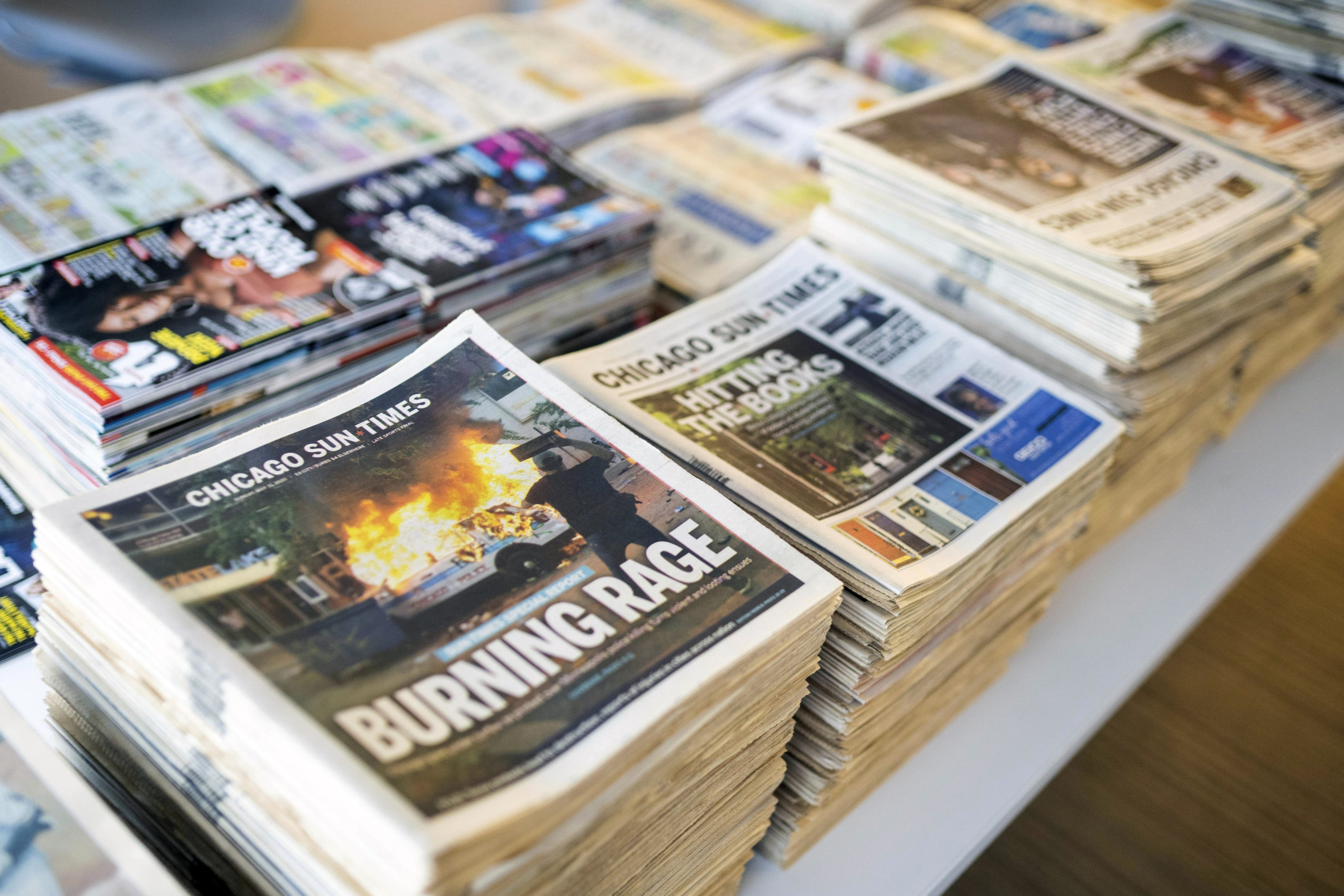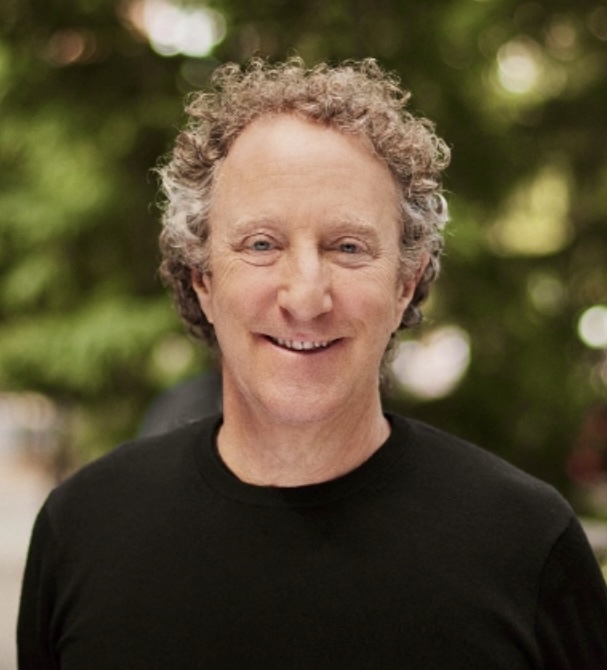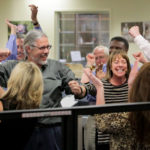
The combination of two storied Chicago news brands has created one of the country's largest local nonprofit news organizations. Chicago Public Media, which owns WBEZ, the local NPR affiliate, announced Jan. 31, 2022 it completed a deal to buy the Chicago Sun-Times
One year ago this week, Chicago Public Media announced the acquisition of The Chicago Sun-Times, a public radio station combining forces with a cherished hometown newspaper. The Chicago merger has created one of the largest nonprofit news enterprises in America, with nearly 200 journalists producing coverage that reaches one in three Chicagoans, according to CEO Matt Moog.
If Moog was the architect of the WBEZ/Sun Times combination, then MacArthur Foundation President John Palfrey was one of its principal builders. MacArthur was the lead investor in a reported $61 million effort to support the growth and sustainability of the new organization. A broad coalition included 11 funders, among them the Knight Foundation, the Pritzker Traubert Foundation, Builders Initiative, and Michael Sacks, a previous co-owner of the Sun-Times. The speed and scale with which this capital raise came together was impressive, instructive to other communities in need of local news investment, and a kind of teaching moment for our field.
This past weekend Palfrey and his co-host, Chalkbeat co-founder and CEO Elizabeth Green, convened a gathering of roughly two dozen current and prospective journalism funders and practitioners at a conference facility at Sunnylands, the former Annenberg estate in Rancho Mirage, California, outside of Palm Springs. While not framed as such, Sunnylands was in effect an effort to model Chicago and other encouraging local funding collaborations at much grander national scale.
Related Posts
The Lenfest Institute, where I am executive director and CEO, was a part of the host committee of this summit, which involved advanced planning as well as input into a draft “Roadmap for Local News,” co-authored by Green, Free Press Senior Director of Journalism Policy Mike Rispoli and City Bureau Co-Founder and Co-Executive Director Darryl Holliday. The road map — a work in progress — was published today with an open, inclusive call for new input.
The roadmap reflects interviews with more than 50 leaders in the field to date and makes the case for big and bold action like we saw in Chicago. It is first and foremost a reframing of the issues and the opportunities surrounding local news in the face of a crisis in American democracy. Subtitled “An Emergent Approach to Meeting Civic Information Needs,” the roadmap frames the challenge and opportunity less as saving local news than reinventing and revitalizing civic information in service of communities. Among its key goals and recommendations:
- More Money: Meaningfully increase national and local philanthropic funding for local journalism/civic information.
- More Efficient Infrastructure: Leverage new and existing shared services or solutions providers serving multiple news organizations inexpensively and at scale.
- Better Policy: Help create state and federal policy that improves the economics of local news.
The purpose of the Sunnylands convening was to begin to galvanize funders, news organizations and supporting organizations to think and act much more aggressively. As MacArthur’s Palfrey framed it, the goal was “to pair great need with great opportunity, to do something more, something different, and something meaningful.”
I arrived at Sunnylands a bit apprehensive and left quite encouraged.
My apprehension was rooted in practical concerns over the prospective creation of a kind of mega-fund that might prove unwieldy, difficult to govern, or expensive in its own right.
A second concern was that efforts to build enabling infrastructure might take on an infrastructure of their own. This same logic of efficiency was a working principle of the newspaper chains of yesteryear, and their centralized services were often burdensome and inefficient.
Most funders seemed aligned in the view that coordinated effort toward common goals and funding of key priorities could best be accomplished through close communication and coordination rather than consolidation into a kind of fund of funds. Federation not consolidation. Amy Low of Emerson Collective expressed it well, advocating for a “distributed” funding model that was both aligned and “decentralized,” much like the news business it seeks to support.
The Knight Foundation’s Jim Brady, a self-described “infrastructure geek,” made the case for efficient, nimble, on-demand “fractionalized services,” rather than a single source of news tools or centralized back-offices services.
The three-day sessions began with a scene setter by Nancy Gibbs, the long-time editor-in-chief of Time Magazine and now the director of Harvard’s Shorenstein Center. She flashed several familiar charts but framed them especially compellingly:
The first is the Thelma and Louise-like revenue cliff that shows commercial newspaper funding decline from nearly $50 billion to less than $10 billion since 2005. “This is what the apocalypse looks like,” she said, adding, “We are contending with the disruption of the entire ecology of information in this country and around the world.”
The second was a parallel chart showing the decline of working journalists in America; “Democracy needs journalism, and guess what, journalism needs journalists.”
Gibbs was one of several voices this weekend to suggest that the crisis in local news is aided and abetted by a lack of awareness that there is a problem in the first place. She cited Pew Research data that 70% of Americans believe their local news outlets to be “doing well” financially. “If people don’t know their house is on fire, good luck organizing a bucket brigade.”
This reframing of the conversation from saving the news industry to the broader imperative of civic information to enable a thriving democracy pervaded the weekend.
Despite all the challenges facing local news — or perhaps because of them — there are a growing number of instances in which creativity, capital, and community coalesce to rebuild local news. As of early 2023, there are relatively new investments of meaningful scale and ingenuity in Chicago (WBEZ/Sun-Times), Baltimore (The Baltimore Banner), Cleveland (Signal Cleveland), Pennsylvania (The Philadelphia Inquirer and Spotlight PA), Syracuse (Central Current), Santa Cruz (Lookout Santa Cruz and Santa Cruz Local), and many other communities large and small.
Each is a bit different. The Inquirer and Lookout operate as for-profit public benefit companies, while Cleveland, Baltimore, Spotlight PA, Chicago, and Syracuse are nonprofits. The Banner, The Inquirer, and the print version of the Sun-Times sell subscriptions; the others, including the digital Sun-Times, offer content for free but appeal for membership support. WBEZ merged with its hometown paper; The Inquirer sometimes competes for news and talent with its local public radio station, and the Central Current is housed in theirs.
No one size fits all. Each approach to local news is a kind of “model home,” open for replication by civic investors in other like-minded communities. This view syncs well with funders’ expressed views that they need a menu of investable local news models with tested impact and cases for support.
The spirit of the Sunnylands conversation was that of local news as a big tent rather than a mansion on the hill. There were voices like Holliday, co-founder of Chicago’s City Bureau, which has fielded over a thousand “documenters” to help cover government and school board meetings in seven cities, and Sarah Alvarez, the founder and editor-of-chief of Outlier Media, which provides civic news and information for Detroit. A growing group of civic information providers are advancing new definitions of who is a journalist, new practices in civic data and reporting, and most important, new levels of trust and engagement with under-served communities.
The group included John Bridgeland, former Director of the White House Domestic Policy Council to George W. Bush, and now Co-Chair & CEO of More Perfect, “an initiative to protect and renew American democracy,” suggesting at least the possibility of bi-partisan support for local news, a goal that has so far eluded recent legislative efforts.
The notion of a big tent extends to making the case to a much broader group of funders and on behalf of a growing array of local news and civic information alternatives — legacy BIPOC-owned media, start-up for-profit solutions, public media, nonprofit news, keeping or returning traditional hometown newspapers in or to local ownership, and more.
Despite the legitimate sense of optimism and momentum, the prevailing winds are still very much in our faces, underscoring the need for significant new investment and collective action. Half of American newspapers are owned by hedge funds or private equity, run to optimize the flow of cash not information. The most economically healthy part of local news — local TV — is often the shallowest or the most sensational.
Nonprofit news remains a promising but relatively small market, not only with respect to funding, but also, some would argue, in terms of consumer demand. Some promising experiments are still just that. The next few years will help determine the extent to which non-profit organizations can truly fill the gap. Sunnylands reflected the non-profit news field’s determination and served to accelerate its continuing strong spirit of collaboration.
One of the most refreshing dimensions of Sunnylands was the presence of philanthropists not yet funding journalism. These colleagues were enthusiastic about the mission but made clear that our field needs to do a much better job making its case for support. Funding for American journalism is still a very small subset of larger beneficiaries, such as education, healthcare, and the arts. That is both the challenge we face and the dynamic we seek to change.
The overarching takeaway from Sunnylands is extraordinarily positive. While there’s a great deal of work to do, there’s a great and growing movement to do so.
Jim Friedlich is Executive Director & CEO of The Lenfest Institute for Journalism, the non-profit owner of The Philadelphia Inquirer, co-founder of Spotlight PA, and supporter of sustainable solutions for local news nationwide. He is a former executive of The Wall Street Journal.






